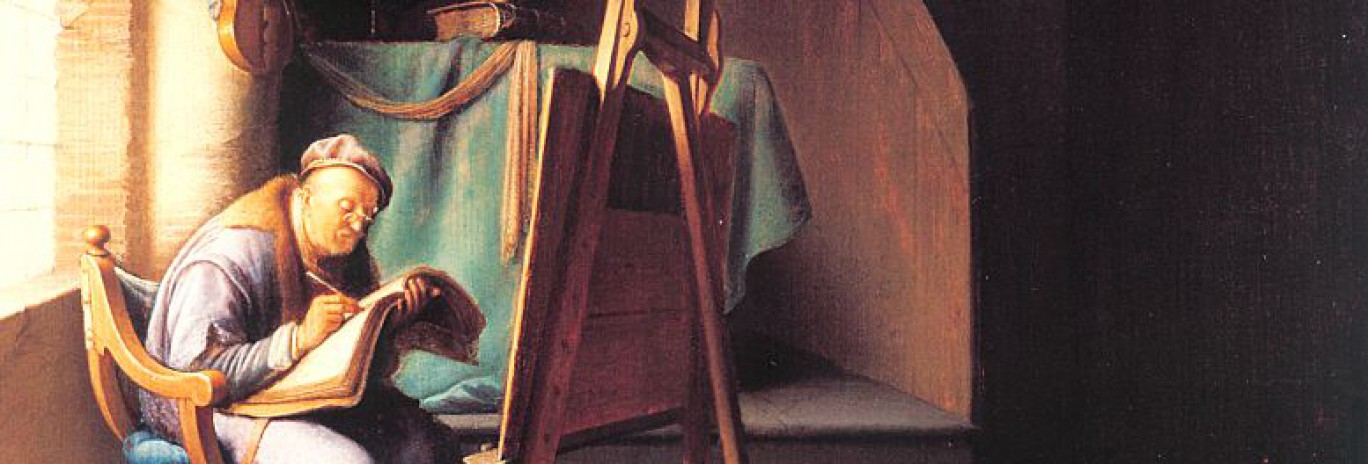Events
TECHNICAL ART HISTORY COLLOQUIUM – Artists’ Palettes
Lectures by Céline Talon (Paintings Conservator and Art Historian, Brussels), Dr. Gianluca Pastorelli (Conservation Scientist, Centre for Art TechnologicalStudies and Conservation (CATS), Copenhagen) and Carol Pottasch (Senior Paintings Conservator, Mauritshuis, The Hague)
Registration is required, rsvp before 5 March 2020 by sending an email to m.l.schans@uu.nl.
Artists’ Palettes
PALETTES AND COLOUR MIXTURES IN NORTHERN RENAISSANCE PAINTING TECHNIQUE
Celine Talon, Paintings Conservator and Art Historian, Brussels
Celine Talon will present the framework for her ongoing research into the palettes of Northern painters, as depicted in paintings and illuminations. The aspects she considers include their shape and size, as well as the variety of colours represented on them. This is combined with material analysis of paintings, and contemporary discourse and treatises on colour. In this presentation, she will focus on small fifteenth-and early sixteenth-century palettes and their correlation with medieval colour aesthetics and the development of the oil medium. A self-portrait by Catharina Van Hemessen’s will be used as a case study.
OPTICAL ILLUSION OR ACTUAL REPRODUCTION? UNFOLDING GIJSBRECHTS’ PALETTES
Dr. Gianluca Pastorelli, Conservation Scientist, Centre for Art Technological Studies and Conservation (CATS), Copenhagen
Painters’ tools and materials are recurrent themes in trompe l’oeil paintings by Cornelis Nobertus Gijsbrechts (c. 1640 – c. 1675), including palettes arranged according to tradition. Did the colours on Gijsbrechts’ illusionary palettes mirror the actual materials – and thereby the painting practice of his time – or did they serve as another layer of optical illusion or iconographic message? Using a range of noninvasive analytical techniques, the composition of the paints in Gijsbrechts’ painted palettes were investigated and compared to 17th-century painting practice.
PALETTES AND SELFIES
Carol Pottasch, Senior Paintings Conservator, Mauritshuis, The Hague
The 2016 exhibition at the Mauritshuis ‘Selfies of the Golden Age’ brought together 27 Dutch self-portraits, half of which depict an artist with their palette. Conservators used handheld X-ray fluorescence spectroscopy (HH-XRF) to investigate whether the paints represented on the palette were used in the rest of the portrait. They also considered the brushes, the depiction of a “painting within the painting”, and how the artists chose to portray themselves. Five self-portraits spanning different time periods and cities in the Netherlands are presented as case studies: Jacob Willemsz Delff (Rotterdam, c. 1590), Judith Leyster (Haarlem, c. 1630/32), Thomas Willeboirts Bosschaert (Antwerp, 1636/37), Cornelis Bisschop (Dordrecht, 1668), and Willem van Mieris (Leiden, c. 1705). The presentation will discuss what we can learn from these paintings.
Images: details from Catharina van Hemessen, Self-portrait, c. 1527-28, Kunstmuseum Basel; Cornelis Norbertus Gijsbrechts, A cabinet in the artist’s studio, 1670-71, Statens Museum for Kunst, Copenhagen; Willem van Mieris, Self-portrait, c. 1705, Lakenhal, Leiden.
The Technical Art History Colloquia are organised by Sven Dupré (Utrecht University and University of Amsterdam, PI ERC ARTECHNE), Arjan de Koomen (University of Amsterdam, Coordinator MA Technical Art History), Abbie Vandivere (University of Amsterdam, Coordinator MA Technical Art History & Paintings Conservator, Mauritshuis, The Hague), Erma Hermens (University of Amsterdam and Rijksmuseum) and Ann-Sophie Lehmann (University of Groningen). The Technical Art History Colloquia are a cooperation of the ARTECHNE Project (Utrecht University and University of Amsterdam), the Netherlands Institute for Conservation, Art and Science (NICAS), the University of Amsterdam and the Mauritshuis. The ARTECHNE project has received funding from the European Research Council (ERC) under the European Union’s Horizon 2020 research and innovation programme (grant agreement No 648718).



